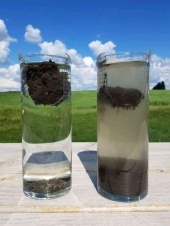I strongly recommend that you take a look at the YouTube videos brought up by these search words: "Brad Lancaster Harvesting Rainwater"
When you say dig, be very careful to understand how swales work to spread, slow, and sink rainwater into your soil. The high clay content will cause water to collect and take longer for it to soak into the soil where it becomes available for vegetation. In areas where you want to plant things, consider using hugelkulture to create underground "organic sponges" to absorb the water.
In your case, you will need to develop the idea of a water-based food forest with a balance of aquatic lifeforms that will keep your ponds from becoming stagnant pools of algae. Look into the ideas of "swimming ponds" for their use of biological approaches to filtering the water of excess nitrates.
Here's a commercial site for starters:
https://odu-green-roof.com/swimming-ponds/ 
This site has some more passive designs that might be more useful to meet your needs:
https://insteading.com/blog/natural-pools-swimming-ponds/
This site came from a search on the terms, "building a Fish Pond", which may be more to your specific needs:
https://insteading.com/blog/natural-pools-swimming-ponds/
The following sites are about the potential of using livestock to build up the soil:
Raincrow Film LLC Occam's Grazer: An In-depth Introduction to Holistic Management
Greg Judy VABF 2011 USING ANIMALS TO HEAL THE LAND
Ian Mitchell-Innes Interview on Holistic Management Planned Grazing
My point is that you should do some calculations for each water-control structure that you intend to "dig". Calculate the square footage of each "watershed" and multiply by the amount of rain that you can expect from any one storm. Make sure to keep track of your units to avoid over or underestimating the volume of water that can be produced by any rain event. Digging may be too strong of a word for water management using swales. The square foot measurement of an area can hold many gallons of water with only a few inches of depth depending on how much slope your land has.
Always plan for how and where the water will go when (not if) your swales fill with water. The whole point of swales is to allow rainwater to soak into the ground, where it will become available for vegetation. Make sure that any ponds that you build are not too small for the potential rainfall that they will be collected, and that you must control any overfows that will occur.
Since the fish ponds seem to be a primary goal, spend a lot of planning time to think through the water cycle that you are creating. Ponds change with the seasons. Plan on introducing a variety of water-based vegetation, like cat tails and water lillies to filter the runoff from the drainage that fills your ponds. You probably do not want a bunch of rotting vegetation in your fish ponds. You are creating an ecosystem of aquatic plants and animals, not a fish farm.
You do not mention where your land is located, and what sort of slopes you are dealing with.These are very importand design elements to consider.
Using a system of paddocks to manage a suitable mix of livestock (cows, pigs, goats, sheep, llamas, horses, and even chickens can all be considered as cattle, aka livestock) can greatly enhance the establishment of the vegetation to control erosion and runoff. The electric fences keep your herd moving and also keep the livestock from getting into your ponds while still being able to have access to the water of the pond.
The method of pasture management is based of the principle that you are using the cattle to mow the perennial grasses of the paddocks, and to manage the lifecycle of the diversity of plants that grow in the paddock. After a while, the seeds of native plants and grasses will find your pasture and self-propagate. A mixture of prairie grasses will not need to be roto-tilled or re-seeded: the animals' hoofs do all of that as they harvest and traample the plants. You never let the cattle overgraze any paddock. Compared with more traditional grazing methods, you may be accused of undergrazing, but remember, one of your primary goals is to build topsoil, which is why you let the herd trample the uneaten forage. This serves two purposes: it shades the bare ground and it leaves much more organic material, which is what ends up as new topsoil.
The basic idea is that you only let the cattle graze in a paddock
at the proper time in the lifecycle of the grass, and then you keep the cattle away from that paddock as it recovers. You control the number of animals and the timing of the grazing animals' access to each the paddocks. Depending on the severity of the winter at your location, the raising of cattle is a year-round process.
One thing about a natural pasture is that
there ARE no weeds. The animals will eat almost any vegetation, especially if you include goats in your mix of fauna. Over time, the best-adapted native grasses will take over and strangle out the less-desirable species. The only restriction is some animals should not be allowed to eat certain plants. Consult a veterinarian about any potentially dangerous plants for whichever livestock animals you may choose to use.
If you have enough difference in elevation and access to wind and
solar power, you could also use pumped water energy storage to supply the energy to have artificially maintained running streams. (The principle of stacking functions). This may be a level of complexity that you may not want to deal with.
If you must dig holes to plant your trees, be sure to allow a means for sub-surface water to drain away from the "pothole", or you risk drowning the tree when the clay prevents the proper sub-soil drainage. Consult further with Bryant RedHawk for better advice on the care planting of trees in clayey soils.
Asparagus is usually propagated by planting root "plugs" on top of a bed of compost buried about a foot below the surface, covered over with topsoil. It usually takes about three years for a root mass to start producing the edible shoots. I have only done this once, and I had to move away from the garden where I planted them, so I didn't get to see how they did. I've never tried to directly plant the seeds.
Good luck with whatever you decide to do.

 1
1




 5
5













 9
9













 2
2








 3
3










































 1
1


























 1
1






 1
1




 1
1




 1
1




![Filename: Screenshot_20180828-005729_Samsung-Internet_crop_570x506.jpg
Description: [Thumbnail for Screenshot_20180828-005729_Samsung-Internet_crop_570x506.jpg]](/t/91644/a/64382/Screenshot_20180828-005729_Samsung-Internet_crop_570x506.jpg)

 1
1




![Filename: thumb-20151107_112413-480x853.jpg
Description: [Thumbnail for thumb-20151107_112413-480x853.jpg]](/t/91644/a/64383/thumb-20151107_112413-480x853.jpg)

 1
1








 1
1





 3
3








 2
2




 1
1




 1
1





















